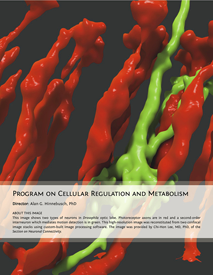You are here: Home > Program in Cellular Regulation and Metabolism
Program in Cellular Regulation and Metabolism
Director: Alan G. Hinnebusch, PhD
The seven investigators in this program, all belonging to the Laboratory of Gene Regulation and Development (LGRD) (LGRD), share a common interest in using genetically tractable model organisms and a combination of genetics, biochemistry, cell biology, and structural biology to elucidate the molecular basis of processes fundamentally important in cell biology or animal development. Three groups employ yeast as a model system, with two studying molecular mechanisms of transcriptional and translational control of gene expression in budding yeast, and a third studying transposition of mobile elements in fission yeast. Two groups employ the fruit fly Drosophila to investigate development and function of neural circuits, including synaptic specificity in the visual system and assembly and growth of synapses at the neuromuscular junction. The anuran Xenopus laevis serves as a model system for the work of the remaining two groups, one of whom focuses on spindle assembly and chromosome segregation and the roles of covalent protein modification by SUMO in regulating these events, and the other on transcriptional programming during the postembryonic formation of adult stem cells.
Members of the Section on Nutrient Control of Gene Expression, headed by Alan Hinnebusch, study fundamental mechanisms of transcriptional and translational control of gene expression in budding yeast. Recently, they demonstrated that enhanced binding of translation initiation factor 1 (eIF1) to the 40S ribosomal subunit impedes conformational rearrangements of the preinitiation complex (PIC) required for start codon selection and thereby elevates initiation accuracy; they also provided evidence that eIF5 promotes initiation accuracy by regulating both GTP hydrolysis and conformational rearrangements of the PIC. They further demonstrated that conserved nucleotides in initiator methionyl tRNA calibrate initiation accuracy by regulating preinitiation complex stability at the start codon. Phosphorylation of eIF2α by protein kinase Gcn2 down-regulates bulk protein synthesis during starvation and stress, and the group established that direct interaction between the pseudokinase and kinase domains in Gcn2 stimulates eIF2α phosphorylation in amino acid–starved cells.
The Section on Cell Cycle Regulation, headed by Mary Dasso, studies cellular pathways that assure the integrity of genomic transmission during each cell division in higher eukaryotes, including mechanisms of mitotic chromosome segregation. Members of the group showed that proteins previously described for their functions in interphase nuclear-cytoplasmic protein trafficking are critical for correct spindle assembly and mitotic progression, and they are studying the details of these functions, as well as mitotic roles of the SUMO protein modification pathway. They also recently described the function of IRBIT, a novel inhibitor of ribonucleotide reductase (RNR). RNR supplies deoxynucleotide triphosphates for DNA replication, and its uncontrolled activity is associated with malignant transformation and tumor cell growth. They found that IRBIT is essential for proper cycle progression and genomic integrity, and they are currently exploring IRBIT’s physiological activities and regulation.
The Section on Protein Biosynthesis, headed by Thomas Dever, is characterizing the structure and function of translation initiation factors and stress-responsive eIF2α kinases that control cellular protein synthesis, as well as viral regulators of these kinases. Members of the group recently demonstrated that the hypusine-containing protein eIF5A promotes translation elongation by facilitating the reactivity of poor substrates such as proline. They also characterized a human X-linked intellectual disability syndrome caused by a mutation in eIF2γ that impairs eIF2β binding, thus providing a molecular basis for the human disease, and they identified a protein phosphatase PP1–binding site in yeast eIF2γ that targets PP1 to dephosphorylate eIF2α.
Henry Levin heads the Section on Eukaryotic Transposable Elements, which analyzes the integration of LTR retrotransposons, retroviruses, and DNA transposons into the chromosomes of host cells. Recently, the laboratory developed new methods of deep sequencing that yield ultra-dense profiles of integration. Dense maps of retrotransposon Tf1 integration in Schizosaccharomyces pombe demonstrated that the promoters of stress-response genes are actively targeted. In other studies, dense maps of HIV-1 integration in cultured human cells reveal that cancer-related genes are among the most frequently disrupted. The lab also adapted the Hermes transposable element from the housefly to generate maps of unprecedented density in S. pombe. The profiles of Hermes integration yielded comprehensive sets of essential genes and genes with roles in heterochromatin formation.
The Section on Neuronal Connectivity, headed by Chi-Hon Lee, investigates the assembly and function of chromatic circuits in Drosophila. His group combines imaging and genetic approaches to determine the mechanisms by which optic lobe neurons elaborate dendrites in stereotypic patterns to form appropriate synapses. The group recently identified several molecular cues, including TGF-beta/Activin, that control dendritic morphogenesis and synaptic specificity. For studying visual functions, the group mapped the visual circuits involved in innate and learned color-driven behaviors and identified the synaptic components involved in signal transmission.
The Unit on Cellular Communication, headed by Mihaela Serpe, investigates molecular mechanisms that regulate cellular signaling during development, employing the Drosophila system. Recently, members of the group identified Neto (Neuropillin and Tolloid-like) as an essential auxiliary subunit required for the assembly and function of glutamatergic synapses at the fly neuromuscular junction. They established that (i) Neto enables clustering of glutamate receptors at synaptic sites, but only after its inhibitory prodomain is removed by Furin-mediated proteolysis; (ii) prior to stabilization of synaptic receptors, synaptic transmission occurs but postsynaptic differentiation is not initiated; and (iii) Neto regulates a local, non-canonical signaling pathway, involving the TGF-β family member BMP, that provides a molecular sensor for synapse activity.
The Section on Molecular Morphogenesis, headed by Yun-Bo Shi, studies the gene-regulatory mechanisms controlled by the thyroid hormone receptor (TR) that establish the postembryonic developmental program in vertebrates. Using the TALEN–mediated gene-knockdown approach, members of the group demonstrated that TRα and the histone methyltransferase Dot1L, a potential TR coactivator, are important for Xenopus tadpole growth and development. They also identified and characterized candidate thyroid hormone–regulated genes involved in adult intestinal stem-cell development during Xenopus metamorphosis.


